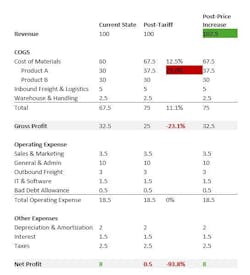Tariffs and Pricing Adjustments: A Roadmap for Manufacturers
As it stands today, the U.S. has imposed a 10% tariff on China and is ready to impose 25% tariffs on Mexico and Canada later this month—affecting over $1 trillion in imported goods. Of course, this could all change tomorrow. Such is the volatility manufacturers operate in today.
It’s hard to say what tariffs will hit when, but it’s safe to assume that when they do, the impact will be monumental. To maintain profitability and keep strong customer relationships, manufacturers should be ready to adjust their pricing accordingly and communicate those changes well. History has taught us that companies that move quickly to adjust pricing tend to maintain profitability better than those who hesitate.
When adjusting, it’s important to remember that manufacturers have the power to push price beyond general inflation. Businesses that successfully passed on rising costs due to supply chain disruptions and heightened demand through the COVID-19 pandemic are evidence of this. So is the rising Producer Price Index (PPI), which measures the selling prices received by domestic producers. From January 2020 through December 2024, it rose 22%.
Pricing conditions have normalized, but tariffs are changing the equation again. Here are 4 steps that will ensure a savvy, quick reaction when the time comes.
1. Get the facts—know your tariff exposure. Not all tariffs impact manufacturers the same way. Some will see direct cost increases, while others may experience indirect price increases from suppliers. Use the International Trade Commission’s Harmonized Tariff Schedule (HTS) to pinpoint exact tariff rates on materials. Analyze product-level risk by identifying which materials are most impacted, and consider possible alternatives. Secondary costs might also increase, such as freight, storage and labor costs, so figure those in as well.
2. Run tariff impact scenarios and set a pricing strategy. Before taking any action, calculate how tariffs will affect your profitability. While tariffs are a direct cost increase, a 25% tariff doesn’t always warrant a 25% total cost increase, for example. Weighted cost structures and operational efficiencies will influence the final impact. Use a P&L model to determine how tariffs will impact your gross margin and net profitability.
The example below shows that a 25% increase in the cost of Product A results in an 11.1% weighted increase in COGS (cost of goods sold), causing net profit to plummet by nearly 94% if no action is taken. To restore profitability, the company must implement a 7.5% price increase (shown as an improvement in revenue), which is less than the 25% tariff itself.
3. Short term: Communicate temporary increases with transparency. Whatever price increase is chosen, act swiftly and with transparency. Set expectations of potential tariff-related increases by explaining why pricing is changing and when it might reverse. Create a separate line-item on quotes and invoices for a temporary tariff surcharge. This will help you show commitment to your customer relationships.
4. Long term: Stay agile. Tariffs will likely come and go—as will other circumstances that spur market volatility. Regularly monitor developments and competitor responses and be ready to quickly adjust prices accordingly. Data-driven pricing decisions will serve your business well beyond tariffs and proactive customer communication will keep relationships strong.
Manufacturers that act decisively with a mindful, strategic approach can protect their margins and maintain profitability. Implementing quick price adjustments with plenty of customer communication will help companies weather most market storms.
About the Author

Dan Cakora
Pricing Economist, Vendavo
Dan Cakora is a pricing economist and business consultant with vendavo, a SaaS market leader in B2B pricing, selling and rebate solutions. Dan has worked in various aspects of pricing for over 15 years. He started his career as a field economist, responsible for helping to measure inflation for the federal government. Before joining the Vendavo team, Dan was a customer at a large, international B2B distributor. He has led pricing teams, developed pricing and sales enablement products, and has a passion for data visualization. Dan has an MBA from DePaul University and a BS in economics from Purdue University.

